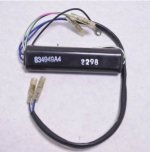Hi!
I have a Mariner 115 Hk -93. This summer 2 problem has revealed. 1) DC voltage increased with increased RPM and 2) Short and high voltage spikes noticed (the DVM suddenly and intermittent lost reading showing just OL. for a short time and the coming back to normal reading) on both DC (red wires to ground) as well as AC side (yellow wires feeding the rectifier/regulator) of the rectifier/regulator. The voltage spikes was verified when I connected an oscilloskop, where the voltage spakes was visibel.
1) Was solved by changing the rectifier/regulator.
2) Still remain. Have even tried to change stator without any result.
Is there any filter function on the adaptor sitting in between the switching box and the stator?
My theory is that the current switching of the ignition coils or switchbox are transferring a high voltage back to the stator and not cut away from a adaptor.
I have measured the adaptor and it shows 0 ohms between green/white to blue/white as well as white/green to blue. All other measurements combination on the adaptor terminals shows infinit resistance.
Best regards Magnus Olsson
I have a Mariner 115 Hk -93. This summer 2 problem has revealed. 1) DC voltage increased with increased RPM and 2) Short and high voltage spikes noticed (the DVM suddenly and intermittent lost reading showing just OL. for a short time and the coming back to normal reading) on both DC (red wires to ground) as well as AC side (yellow wires feeding the rectifier/regulator) of the rectifier/regulator. The voltage spikes was verified when I connected an oscilloskop, where the voltage spakes was visibel.
1) Was solved by changing the rectifier/regulator.
2) Still remain. Have even tried to change stator without any result.
Is there any filter function on the adaptor sitting in between the switching box and the stator?
My theory is that the current switching of the ignition coils or switchbox are transferring a high voltage back to the stator and not cut away from a adaptor.
I have measured the adaptor and it shows 0 ohms between green/white to blue/white as well as white/green to blue. All other measurements combination on the adaptor terminals shows infinit resistance.
Best regards Magnus Olsson




